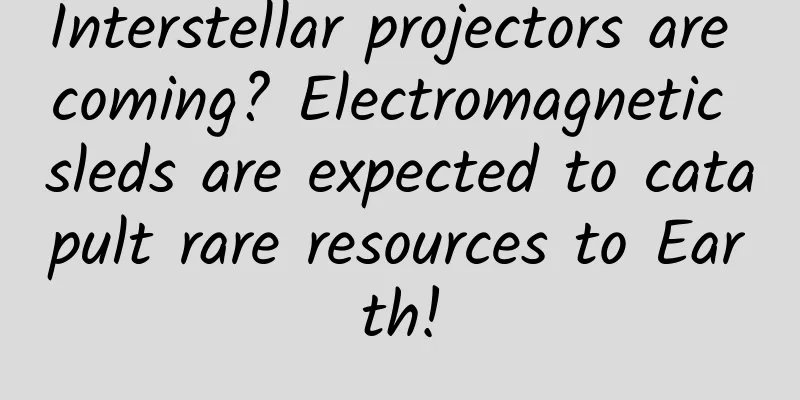Interstellar projectors are coming? Electromagnetic sleds are expected to catapult rare resources to Earth!

|
There are many scientific facilities, but some of them are destined to be brain-opening from the moment they are "born", such as the electromagnetic sled! Electromagnetic sled, picture from CCTV News screenshot. In October 2022, the world's first electromagnetic sled facility was successfully put into operation in Shandong, China. As a major project of strategic cooperation between the Chinese Academy of Sciences and Shandong Province, the electromagnetic sled can propel objects weighing more than a ton to a speed of 1,030 kilometers per hour. When many science fiction fans see the electromagnetic sled for the first time, they can't help but think of the "mass projector" that often appears in science fiction works. A mass projector, also called a mass accelerator, is a tool that uses electromagnetic acceleration. Although there are differences in technical details and names, in terms of underlying principles, the electromagnetic sled, mass projector, and electromagnetic catapult on aircraft carriers are actually the same. It has been more than a hundred years since the mass projector was proposed, and its most widely known application at present is probably the electromagnetic catapult on aircraft carriers. What limits the large-scale and rapid development of mass projectors? The answer is the Earth itself. How to solve it? Change planet. 01 Limitations from Earth At present, electromagnetic sleds can propel objects weighing more than a ton to a speed of 1,030 kilometers per hour. So, through technological improvements and significant expansion of scale, can the speed be pushed to 2,000 kilometers per hour or even 3,000 kilometers per hour in the future? In theory, this should be possible, but it is extremely difficult and costly. Replacing the electromagnetic pry with electrons of much smaller mass gives us the well-known linear particle accelerator. For example, the SLAC linear particle accelerator at Stanford University in the United States is 3.2 kilometers long and can accelerate electrons to 99.9999999% of the speed of light, with an energy of 50 GeV. Aerial view of the SLAC linear particle accelerator, image from Wikipedia. In fact, expanding the scale of the electromagnetic sled by 5 times or even 10 times is not the biggest difficulty. The greatest difficulty comes from the Earth's atmosphere. There is no doubt that the greater the propulsion speed, the greater the atmospheric resistance. When the resistance reaches a certain level, it will become extremely difficult to further increase the propulsion speed, and the cost will be prohibitive. Some netizens may say that electromagnetic acceleration can be carried out in a horizontal and vacuum tunnel, wouldn’t that avoid atmospheric resistance? Yes, it is possible. Without considering the cost and difficulty, let's just say that in this vacuum tunnel, you propel a spacecraft weighing several tons to three times the speed of sound, or even five times the speed of sound. Then what? Do you plan to use it for impact testing? Don't forget that the original purpose of the mass projector was to assist in the low-cost launch of spacecraft. Some netizens may say, then what if we turn the tunnel into an extremely strong large tube and erect it vertically so that it reaches the sky? In that case, wouldn’t it be possible to launch the spacecraft into the sky? Well, as for this question, let's wait until you design a large pipe with a vertical height of more than ten kilometers and that can stand firm. NASA has already thought of what you can think of. Image credit: NASA. Since the earth doesn’t work, let’s change to another planet. 02 Moon Base Predicting when something will happen is extremely difficult and most of the time it is beyond human control. But predicting whether something will happen is much easier. What we want to do is the latter. There is no doubt that humans will build a lunar base, if not in this century, then in the next century, or the century after that. In short, it will be built, this is an obsession of mankind. A proposed lunar base. Image credit: NASA, Kitmacher. Since the lunar base will be established sooner or later, you may wish to use your imagination in advance: If China builds a lunar base in the future, how can it launch ultra-low-cost spacecraft on the moon? Traditional rocket launches require fuel, and this is also true on the moon. On the moon, there are only two possible sources of fuel. One is to bring it from Earth, which is extremely expensive. This is the method used by the Apollo moon landing. Apollo 11 lunar module. Image courtesy of NASA. Transporting fuel from the Earth to the Moon may be okay occasionally, but if you want to maintain a Moon base in this way, this model will almost discourage all countries that want to build a Moon base. Another model is to decompose minerals on the moon and synthesize fuel. With the current level of technology, the difficulty and feasibility of this model are unknown. Even if it is feasible in the future, the cost may be higher than bringing it from the earth. Also, if it is possible to synthesize materials on the moon, then in fact, what should be synthesized most is not fuel, but the source of life - water. Therefore, it is best to frequently launch spacecraft on the moon in order to make full use of the advantageous resources on the moon. The question is, what are the advantageous resources on the moon? The answer is solar energy. The daytime on the moon lasts as long as 14 Earth days, and the temperature can reach up to 150 degrees Celsius in places where the sun shines directly. With such abundant solar energy, there is no big problem in either photovoltaic or solar thermal power generation. In this way, the solar energy resources, which are many times richer than those on Earth, will inevitably provide the moon with an almost inexhaustible supply of electricity. Since the electromagnetic sled only uses electricity, it is only natural to use the electromagnetic sled to launch spacecraft on the moon. 03 Advantages of the electromagnetic sled on the moon The first advantage is, of course, the vacuum environment on the moon. When the Apollo spacecraft landed on the moon, the measured vacuum on the moon was as low as 10 to the negative 10th power Pa, which means that the moon has entered the level of extremely high vacuum - compared to common high-energy particle accelerators, the vacuum inside its acceleration channel is also at the level of extremely high vacuum. For life, vacuum is trouble; but for the electromagnetic sled, vacuum is paradise. Without atmospheric drag, the speed at which you want to propel a spacecraft depends mainly on two factors: One is the size of the electromagnetic sled, and the other is the power supply. The larger the electromagnetic sled, the more land it will take up, but the good news is that land on the moon is currently free. Mass projector. Image credit: NASA. As for the power supply, as mentioned above, there is no need to worry at all. Sufficient solar energy resources can provide sufficient power. Most importantly, this electricity can also be stored using a flywheel. The flywheel energy storage device's favorite environment happens to be a vacuum. The better the vacuum, the longer the flywheel can store energy. The second biggest advantage is the low gravity environment on the moon. The mass of the moon is 0.0123 of the mass of the earth, and its gravity is only one-sixth of that of the earth. Therefore, the escape velocity on the moon is only 2.38 kilometers per second. If the speed reaches 1.32 kilometers per second, it can become a satellite orbiting the moon. 1.32 kilometers per second, is this speed really unattainable? Actually, it is not. Some kinetic energy armor-piercing shells on Earth have a muzzle velocity of up to 1.74 kilometers per second. In other words, if such armor-piercing shells can be fired in a vacuum environment, firing a shell on the moon can become a satellite of the moon. Unit conversion, the picture is a screenshot after calculation on the web page. The low gravity of the moon brings about a lower escape velocity and lunar orbiting speed. As long as the electromagnetic sled can propel the spacecraft to Mach 3.88, it can become a lunar satellite, and if it is propelled to Mach 7, it can escape from the moon. At this point, some netizens may say, is it appropriate to build such a large-scale electromagnetic sled catapult for a lunar base? It is appropriate. Because this may be the only space launch base on the entire moon. After it is built, all moon landing projects of other countries can use it for a fee. Finally, after the base is established, when mining those extremely rare but extremely precious minerals on Earth on the moon, the electromagnetic sled can also be used to directly launch the packaged rare resources into the Earth's desert or boundless grassland. In short, it seems difficult to predict how the electromagnetic sled will be used in the future on Earth. But on the moon, we've thought about it ahead of time. Author: Hanmu Diaomeng, a popular science writer and winner of the "National Excellent Popular Science Work Award" from the Ministry of Science and Technology Reviewer: Luo Huiqian, Researcher, Institute of Physics, Chinese Academy of Sciences Produced by: Science Popularization China Produced by: China Science and Technology Press Co., Ltd., China Science and Technology Publishing House (Beijing) Digital Media Co., Ltd. |
<<: Why does Ice and Snow World only collect ice from the Songhua River?
Recommend
Insights: Don’t put your feet into other people’s shoes
Famous Artists Gallery | Lou Shibai, a native of ...
In-depth reveal of the search promotion ranking mechanism!
Yesterday a classmate asked me: "Why is the ...
Can regularly exposing your back to the sun help beautify your complexion and maintain your health?
The approach is unscientific. From a medical poin...
Stop taking calcium tablets every day! Wrong calcium supplementation is secretly causing "stones" to grow in your blood vessels
Many people feel that they are getting older, so ...
How does the gaming business, which accounts for 83.4% of Bilibili’s revenue, operate?
Recently, bilibili released its IPO prospectus, a...
iOS development · Macros and methods related to iPhone X adaptation
After a long time, today I finally have time to s...
Does iOS really need to be upgraded? Analysis of iOS system upgrades
Whenever a new iOS system is released, whether it...
Deng Jiaxian: The pioneer of China's nuclear weapons development | The childhood of the "two bombs and one satellite" hero
Deng Jiaxian, one of the founders and pioneers of...
How to use the reverse method to improve the bidding effect of Baidu?
Generally, data analysis is done step by step fro...
Put the world into your ears: Listen to FM-1.5 new version first review
On April 30, Beijing Xunting Network Technology C...
Didi Friends Chain
SEO site introduction Souwai Didi Friendly Link P...
Redefining the new standard of smart hardcore off-road, Fangcheng Baobao 8 has completely changed the off-road vehicle industry
The off-road vehicle community may really be abou...
The passion of programmers is actually a kind of pain
[[147859]] I am not a "passionate programmer...
The release of LeEco MAX2 shows how LeEco’s ecosystem drives the mobile phone industry.
LeTV, which creates wind out of nowhere and leads...
7 months to get 10 million fans on Douyin_Free online viewing
From the beginning to profitability, we will brea...






![[Issue 16] Random Talk: Scientist from Zhejiang Province - Xu Shoubo: A pioneer throughout his life](/upload/images/67f22815971de.webp)


